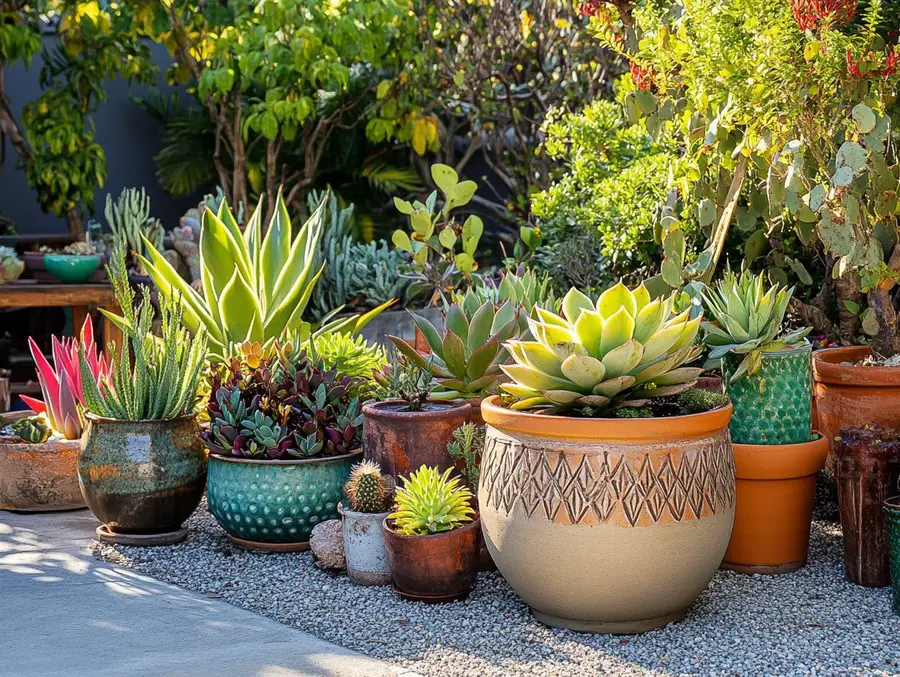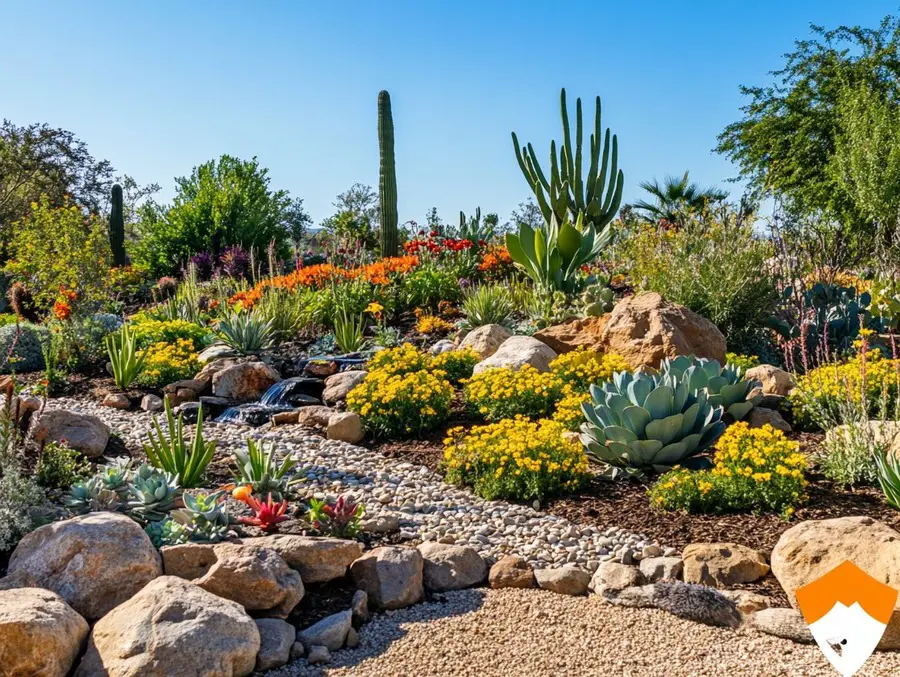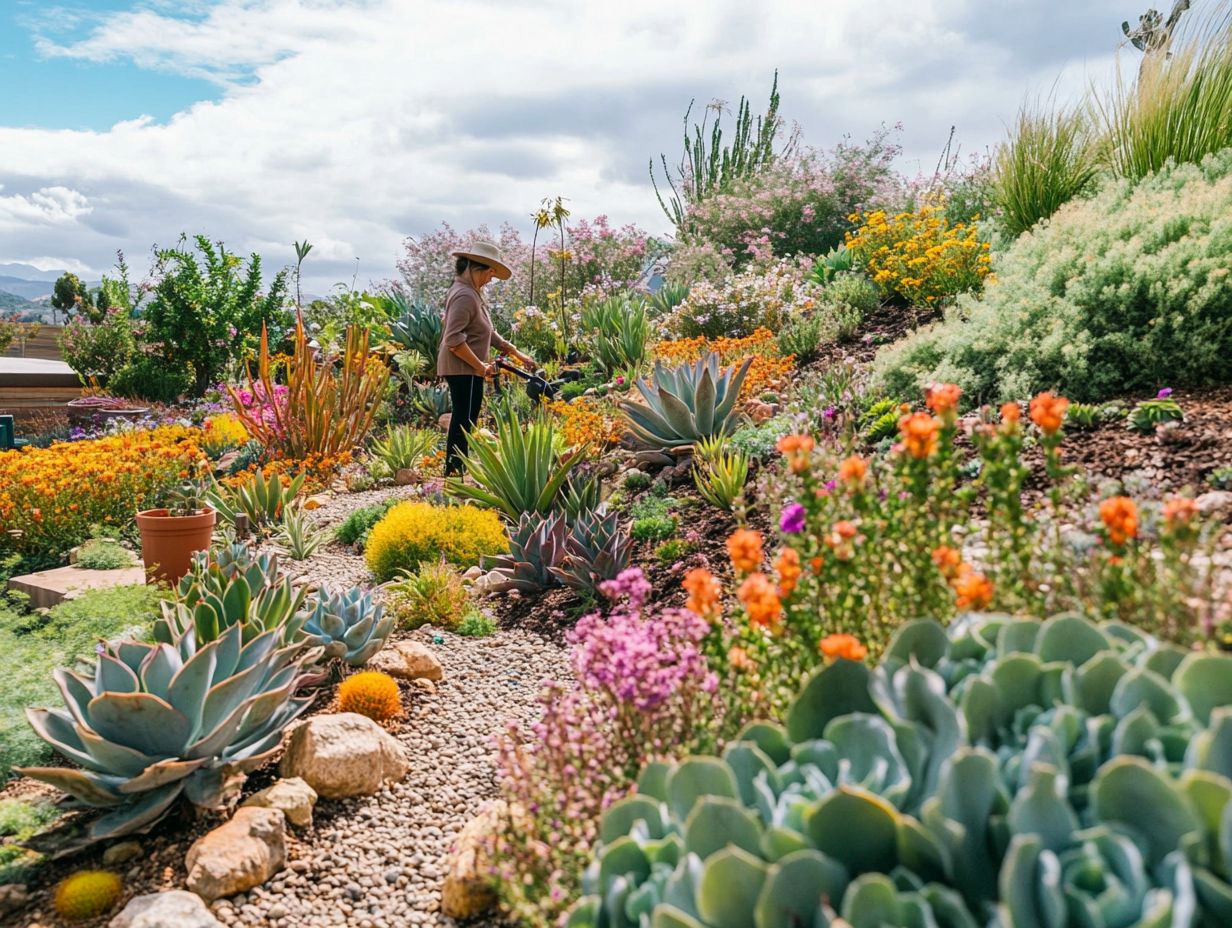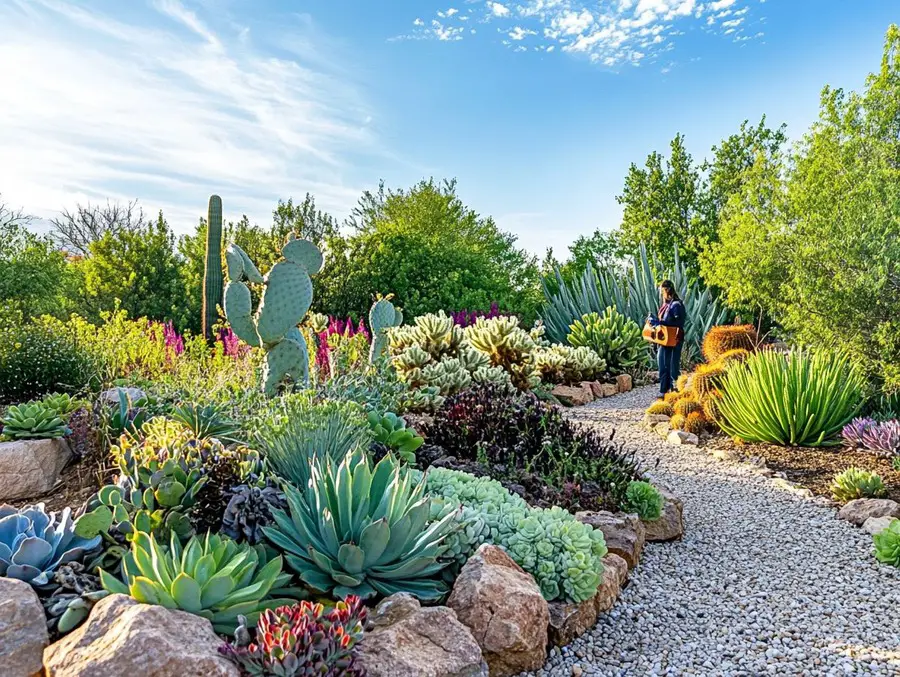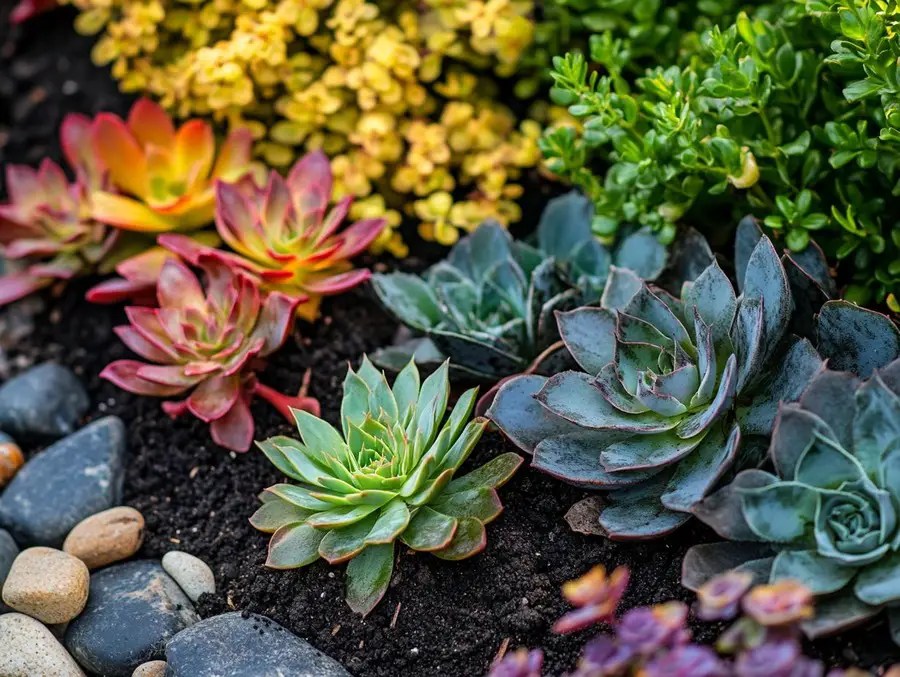We use affiliate links. If you purchase something using one of these links, we may receive compensation or commission.
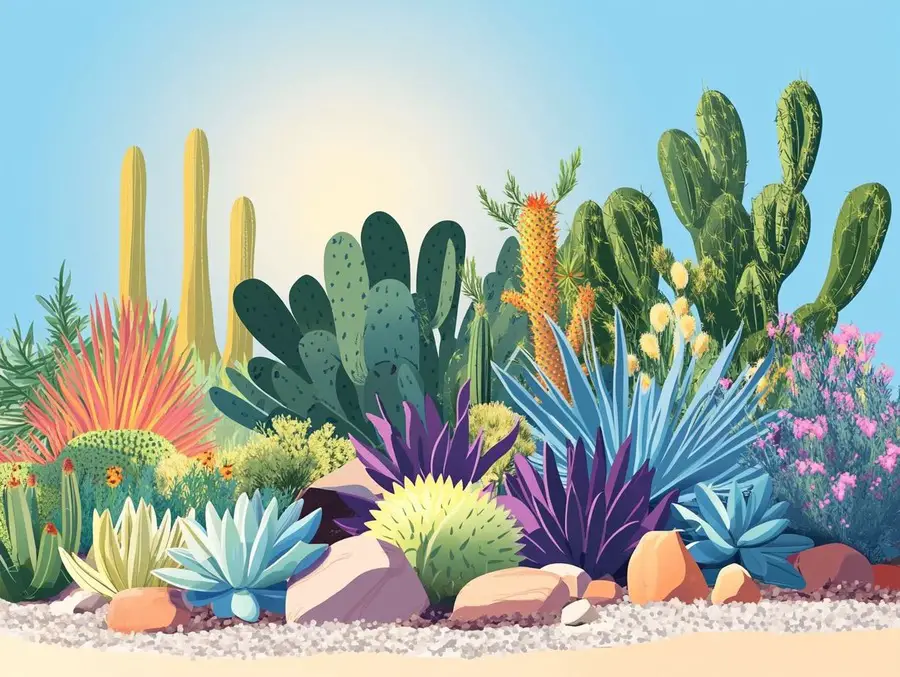
Best Drought-Tolerant Plants for Xeriscaping make it easy to create a beautiful, water-efficient landscape.
Struggling with a dry, hard-to-maintain yard? You don’t need constant watering to enjoy a lush and thriving outdoor space.
With the right drought-resistant plants, you can have a vibrant garden that looks amazing while saving water. Let’s explore the best options for your xeriscape!
Drought-Tolerant Plants for Xeriscaping Key Takeaways
- Drought-tolerant plants for Xeriscaping include succulents, ornamental grasses, and native perennials that thrive in dry conditions.
- Top choices like lavender, yucca, and agave require minimal watering while adding texture and color to your garden.
- These plants support sustainability, reduce water use, and create a low-maintenance yet visually appealing landscape.
Best Drought-Tolerant Plants for Xeriscaping: Thriving with Less Water
Xeriscaping is a sustainable landscaping approach that helps you conserve water while showcasing the beauty of drought-tolerant plants.
This method comes with a bunch of benefits, from helping the environment to saving you some cash in the long run.
You’ll learn how to pick the right species for your garden, explore a variety of drought-tolerant options, and get practical tips on designing a stunning xeriscape that thrives even in arid conditions.
Imagine transforming your outdoor space into a flourishing, eco-friendly oasis!
What is Xeriscaping?
Xeriscaping is all about creating beautiful outdoor spaces while conserving water, making it a fantastic choice, especially if you live in an arid climate.
By focusing on drought-tolerant plants like succulents, cacti, and native flora, and using smart irrigation reduction techniques, you can enjoy a stunning garden that requires less maintenance and has a lower environmental impact.
This eco-friendly approach boosts biodiversity and uses xeriscape principles to enhance the beauty of your garden while promoting sustainable gardening practices.
This method helps minimize your water demand and encourages the use of local species that are perfectly adapted to your specific environmental conditions, creating a more resilient ecosystem.
By incorporating a variety of ground covers, ornamental grasses, and flowering perennials, you can create a vibrant palette that attracts beneficial insects and pollinators.
Xeriscaping can significantly cut down on landscape maintenance costs and time.
With less frequent watering, you’ll spend less time on upkeep.
Implementing these principles can also enhance your property’s value, making xeriscaping a smart choice for environmentally-conscious homeowners eager to make a positive impact.
Benefits of Drought-Tolerant Plants
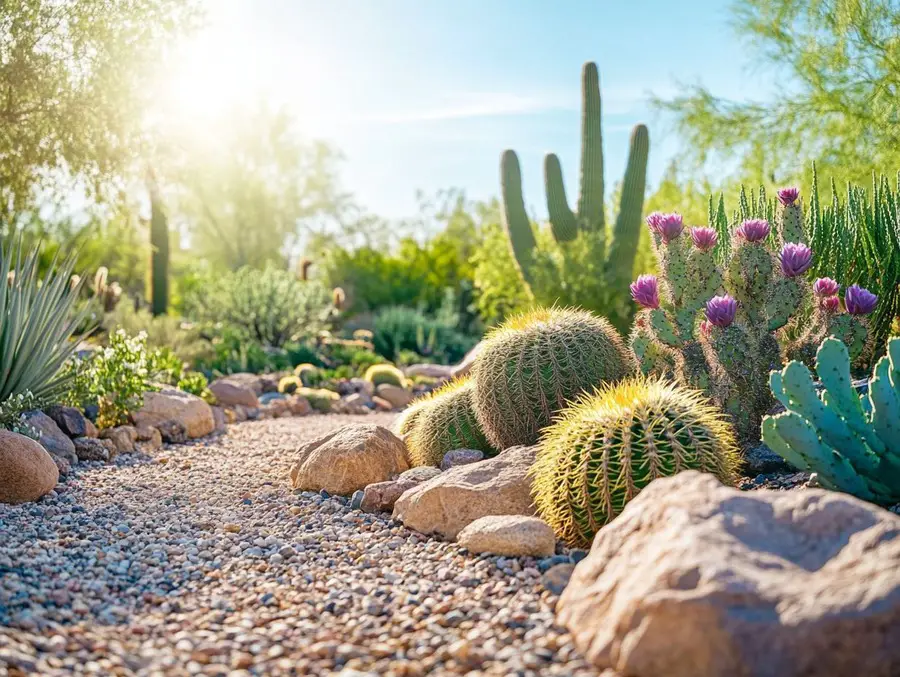 Drought-tolerant plants come with a bunch of benefits that are perfect for both saving the environment and your wallet, making it a win-win for you as a homeowner or gardener.
Drought-tolerant plants come with a bunch of benefits that are perfect for both saving the environment and your wallet, making it a win-win for you as a homeowner or gardener.
These hardy plants, like perennials and ornamental grasses thrive in low-water situations and help you cut down on irrigation costs and maintenance chores.
By opting for drought-resistant varieties, you can create a garden that thrives with minimal resources while also boosting biodiversity and supporting local wildlife.
Environmental and Financial Advantages
The environmental and financial benefits of using drought-tolerant plants in your landscape are pretty impressive.
You can cut down on your water bill, and also help reduce your garden’s carbon footprint.
By choosing plants that need little water, like xerophytes and native plants, you can create a sustainable landscape that thrives even during heatwaves while minimizing the need for extra irrigation.
This is especially handy if you live in a Mediterranean climate, where conserving water is key.
These tough plants also boost biodiversity by providing habitats for local wildlife and pollinators, which is essential for a healthy ecosystem.
Financially, you could save around 50-70% on water costs, making it much easier to keep your landscape looking lush during the hot, dry months.
For example, adding succulents like agave or ornamental grasses cuts down on water use and lowers your maintenance costs over time.
Many municipalities offer rebates for installing drought-tolerant landscapes, so you can make sustainable choices that benefit both your wallet and the planet.
Choosing the Right Drought-Tolerant Plants
Choosing the right drought-tolerant plants is key to creating a garden that really thrives in your local climate and soil conditions.
You’ll want to think about things like plant hardiness, sunlight needs, and the specific growing conditions of your garden zones to ensure everything grows well and looks great.
Don’t forget about companion planting! It can really boost soil fertility and support biodiversity, giving you a sustainable landscape that flourishes even during those dry spells.
Factors to Consider
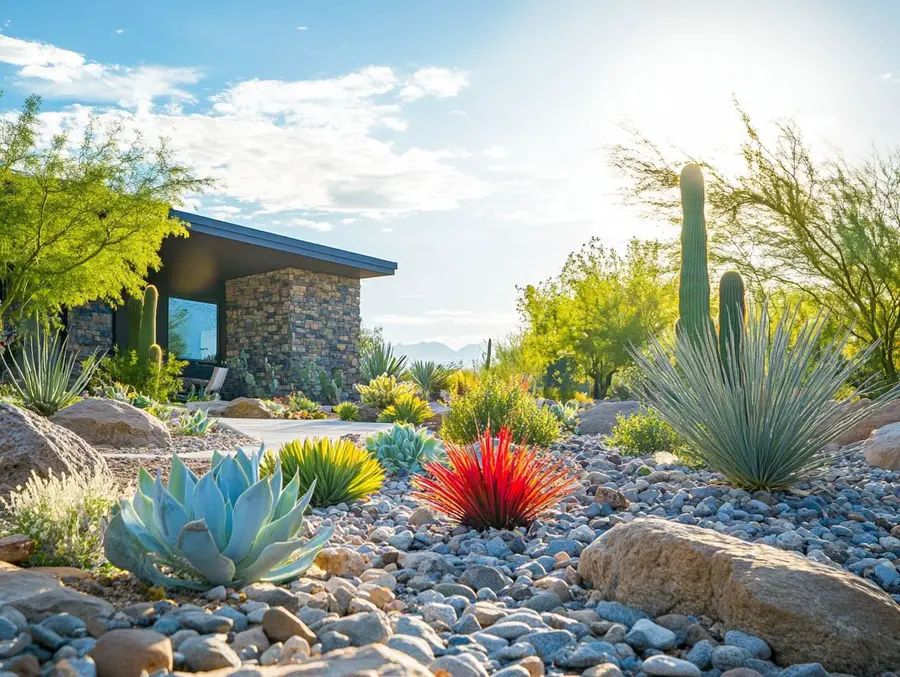
When you’re picking the right drought-tolerant plants for your garden, think about some key factors like soil moisture retention, sunlight needs, and drainage capabilities.
Understanding these elements will help you choose the best species for your specific environment and keep them healthy and looking good for the long haul.
Don’t forget to take temperature extremes and ground cover needs into account, as these can really make or break your garden’s success.
It’s also smart to consider your local climate and the native plant species in your area.
These plants have already adapted to the local ecosystem, which means they usually need less maintenance.
Checking out plant hardiness zones can give you insight into which plants will thrive where you live.
Grouping plants with similar water needs is a great way to maximize efficiency and create a cohesive look in your garden.
And remember to plan for seasonal changes!
Some drought-tolerant plants might flourish in different conditions throughout the year, so keeping that in mind will help you craft a beautiful, sustainable garden that can handle those dry spells.
Types of Drought-Tolerant Plants
You have a lot of options when it comes to incorporating drought-tolerant plants into your landscape to boost both its beauty and sustainability.
From tough native plants that thrive in your local environment to colorful succulents and eye-catching cacti, the choices are endless.
Don’t forget about ornamental grasses.
They bring unique foliage textures and seasonal interest, making them fantastic companions in any drought-resistant garden design.
Succulents and Cacti
Succulents and cacti are some of the coolest drought-tolerant plants you can choose.
They have this amazing ability to store water and thrive in dry climates, making them a fantastic option for your garden.
With all the different shapes and sizes these plants come in, they add some flair to your space and require very little maintenance.
Their low water usage makes them perfect for sustainable gardening, especially in areas that are prone to drought.
Take the vibrant Echeveria cultivars, for instance. They bring a pop of color with their rosette formations, making them ideal for container gardens or rock gardens.
Then you have the iconic Saguaro cactus, which can stand tall as a striking centerpiece in a xeriscape setup, adding some vertical flair next to low-growing ground covers like Sedum.
If you want a cohesive look, it’s all about combining different textures and heights.
This way, each plant’s unique traits can shine while creating a visually stunning arrangement that really captures the essence of the desert landscape.
Drought-Resistant Flowers
Drought-resistant flowers can really amp up the color and seasonal blooms in your garden while keeping water usage low, making them perfect for sustainable landscaping.
Whether you go for native plants or heat-tolerant varieties, these flowering beauties won’t just make your garden look good.
They’ll also attract pollinators and support the ecosystem.
By picking the right combinations, you can create stunning displays that stand strong even in tough conditions.
Mixing in some succulents, like sedums and agaves, with traditional drought-resistant flowers such as lavender and yarrow gives you a delightful textural contrast that’s easy on the eyes.
These combos thrive in dry environments and invite butterflies and bees to join the party.
Don’t forget that regular deadheading and some occasional pruning are key to keeping your garden looking its best.
Think about using decorative gravel or stones as ground cover between those drought-tolerant plants.
This boosts the visual appeal and helps with moisture retention, leading to a beautifully balanced garden that flourishes with minimal resources.
Grasses and Shrubs
Incorporating drought-tolerant grasses and shrubs into your landscape is a fantastic way to boost its structure while providing functional benefits like erosion control and ground cover.
These plants add texture and keep their color throughout the seasons, all while needing minimal water to thrive.
By selecting the right species, you can create a harmonious balance in your garden that promotes biodiversity and attracts pollinators.
Choosing native varieties that are suited to your local climate can significantly reduce your maintenance efforts, as they often need less frequent pruning and fertilization.
These plants beautify your space and they also play important roles in conserving water and supporting soil health.
When you’re combining different species, think about the foliage color, plant height, and blooming periods.
This way, you can create visually appealing layers that keep things interesting all year round.
Grouping plants with similar water needs together boosts sustainability, making sure your garden stays vibrant without putting too much strain on your resources.
Designing a Xeriscape Garden
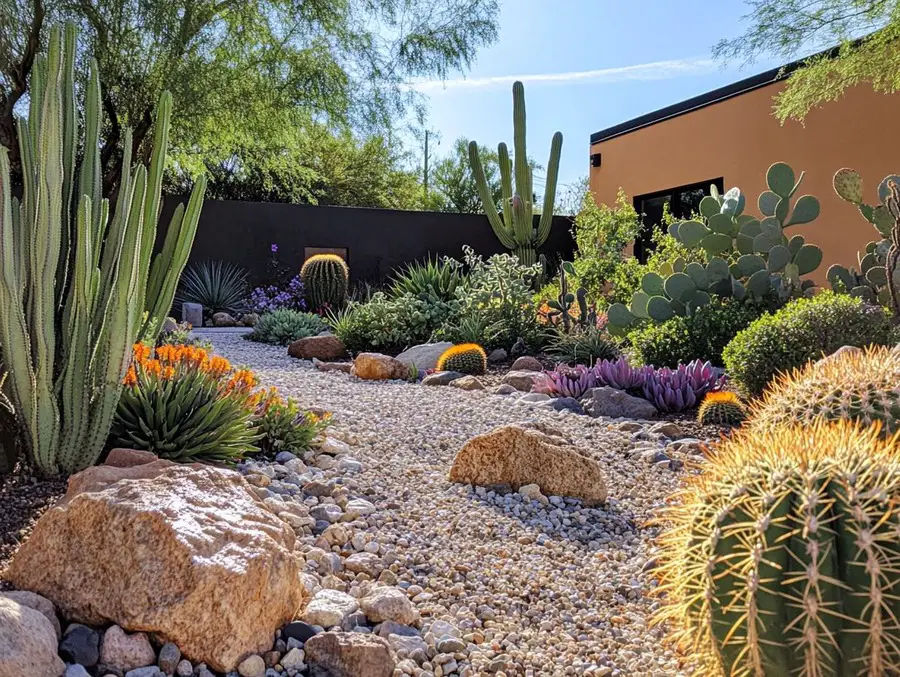 Designing a xeriscape garden is all about thoughtful planning and having an eye for aesthetics.
Designing a xeriscape garden is all about thoughtful planning and having an eye for aesthetics.
You want to create stunning outdoor spaces that require minimal water and maintenance.
By incorporating drought-tolerant plants into your landscaping design, you can embrace sustainable gardening principles while still enjoying the beauty of nature.
From figuring out the garden layout to choosing the right landscaping materials, every little detail plays a role in making your xeriscape stand out all year round.
Tips for Creating a Beautiful and Sustainable Landscape
Creating a beautiful and sustainable landscape is all about careful planning and understanding the perks of xeriscaping.
It’s a fantastic way to conserve water while making your garden look great.
Start by picking out drought-tolerant plants that are suited for your local climate and soil.
You want them to be both eye-catching and good for the environment.
Techniques like reducing irrigation, harvesting rainwater, and using mulch can really boost your sustainable gardening game.
Think about the design layout that maximizes sunlight exposure while still providing some shade for certain plants.
This balance helps create a thriving ecosystem.
Emphasizing native plants cuts down on watering needs and also attracts local wildlife, which is a win for biodiversity.
Stick to regular maintenance practices, like minimal pruning and organic pest control, to lower resource consumption and keep your plants healthy.
By using these strategies, you can cultivate a stunning and low-maintenance landscape that thrives on sustainable principles.
Frequently Asked Questions
What are the best drought-tolerant plants for xeriscaping?
Some popular options include succulents, cacti, lavender, agave, and yucca.
Do these plants require a lot of water?
No, that’s the beauty of xeriscaping! These plants are specifically chosen for their ability to thrive in dry conditions and require minimal watering.
Can these plants withstand extreme heat?
Yes, most drought-tolerant plants are also heat-tolerant and can survive well in hot and dry climates.
Do these plants attract pests or insects?
No, in fact, these plants are known to repel certain pests and insects due to their natural oils and scents.
What are some maintenance tips for these plants?
To ensure their survival, it’s important to regularly prune and remove dead foliage, provide adequate sunlight and drainage, and use mulch to retain moisture in the soil.
Can these plants be used for both landscaping and indoor decoration?
Absolutely! Many drought-tolerant plants are versatile and can be used for both purposes, making them a great choice for xeriscaping.
Best Plants for Xeriscape Gardens: Hardy & Beautiful
Xeriscape Garden Styles: Easy Low-Maintenance Options
Xeriscape Gardening Techniques: Easy Low-Water Tips
Xeriscape Garden Design & Layout: Easy Water-Wise Beauty
What is xeriscaping? A beginner’s guide to drought-tolerant landscaping – Colorado State University
Related Content
Visit my Amazon Influencer Page for videos and gardening products Grow Your Own Garden

